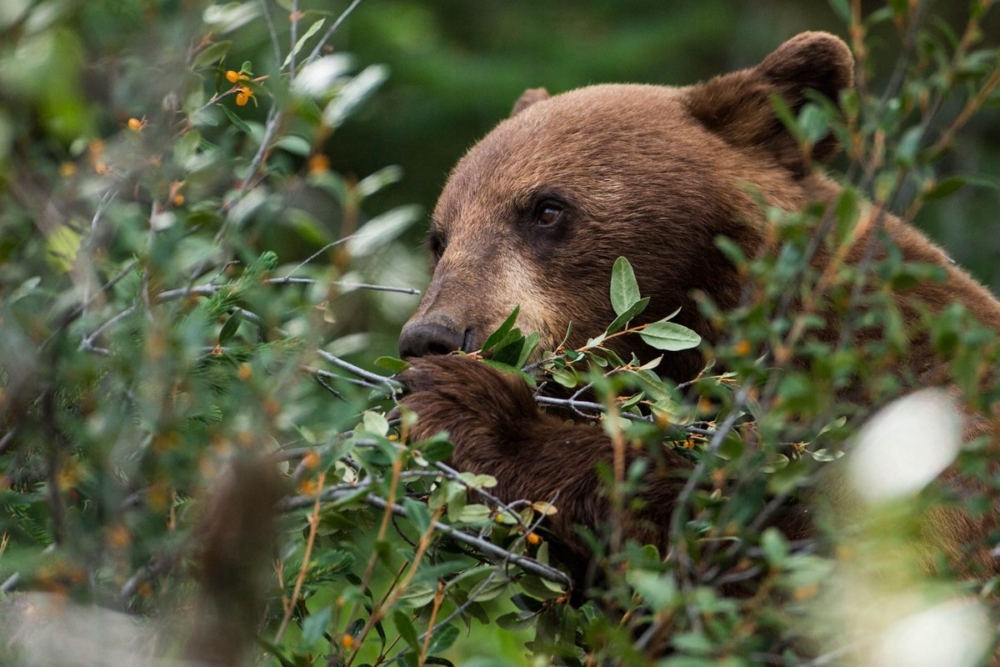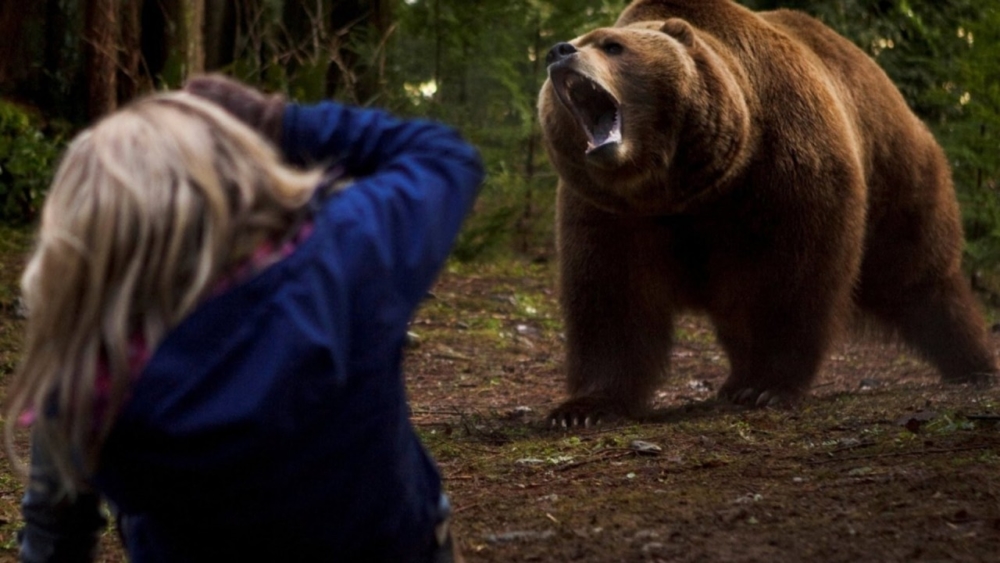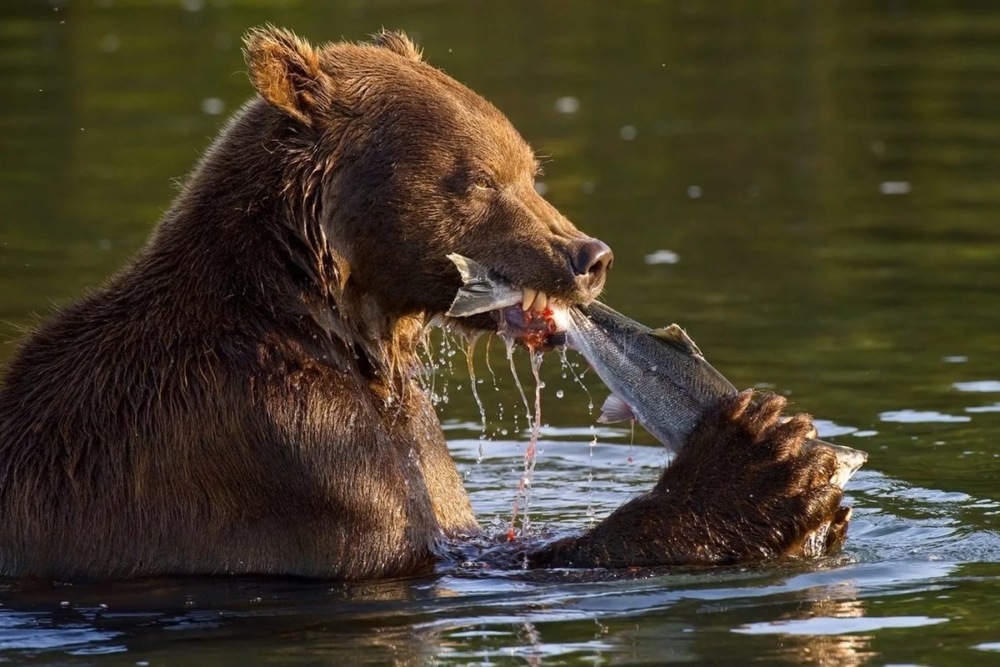It turns out that not every adult can say what the bear eats. Berries, honey and fish are not the only goodies of a predator. Learn more about the diet of this beast.
Material Content:
What do bears eat in nature?
The diet of the animal largely depends on the following factors:
- breed of the beast;
- time of year;
- habitat.
Bears are considered omnivores, only some prefer meat more, while others like fruits and berries.
Their menu consists mainly of plant foods., namely:
- nuts
- stems;
- vegetable and fruit fruits;
- mushrooms;
- mosses;
- berries (bird cherry, raspberry, lingonberry, elderberry, blueberry);
- tree bark;
- plant roots.
The predator remembers places where goodies grow. In addition, bears feed on fish, honey, frogs, rodents, insects and their larvae, as well as other representatives of the animal world.
If there is little food, animals are content with young shoots and the remains of dead mammals. Sometimes they ruin the nests of birds and hunt deer, elk and roe deer, attack domestic animals.
Polar Bear Diet
The white bear is a carnivorous wildlife representative and a well-known predator at the North Pole. He senses his prey through tons of snow and ice. The Arctic beast is very strong and can even throw up a large seal. Now we find out what the polar bear eats.
Its diet consists of foods that are full of vitamins. There are cases when a person was poisoned by the beast's liver. This happened against the background of an overabundance of useful substances. The main food of the predator is seals. He also prefers ringed seals, sea hares, and rarely walruses.
For 12 months, a predator living in the Arctic eats up to 50 seals.Sometimes it feeds on the remnants of the skins and fat of whales that hunters leave.
Brown Predator Nutrition
Any child knows what a brown bear eats. Most of all he loves raspberries and honey. However, its diet is different at different times of the year and depends heavily on crop yields. If there are few berries, then the bear is forced to eat wheat, oat and corn crops. Essential food for a brown beast is cones of cedar, acorns, chestnuts. In Kamchatka, animals are happy to catch salmon in spawning. They love trout.
A brown bear pulls marmots, chipmunks and moles, mice and rats from under the ground. He ruins anthills and apiaries.
Adults prey on wild boars and artiodactyls of small sizes, sometimes attack tigers and wolves. The bear is able to take prey from weak predators. He even eats carrion.
Differences in diet in winter and summer
In the winter season, the polar bear preys on mammals from the subspecies of the toothed whale. He suppresses them with the help of paws. In summer, animals are forced to seek prey on earth. During this period, they eat plant foods, small rodents, polar foxes, ducks and their eggs.
Brown bear eats grass and berries in summer, catches fish, feasts on honey. In the fall, hazelnuts and various fruits are added to the diet. This period for the animal is the season of fat storage, when the clubfoot eats everything that comes in the way.
Many are interested in what bears eat in the forest in winter. In the cold season, they hibernate, and in the spring they go hungry from the den and go in search of larvae, insects, rodents and young needles.
Attacks on people
Hunger drives a bear out of the woods to people's places of residence. Often an animal attacks livestock. If the predator is very hungry, he is able to eat his cubs and even humans.
Attacks on people happen, though rarely, but regularly. Risks increase during the rutting season and without feed. The most dangerous are the connecting rod bears that woke up after hibernation or for some reason did not lie in a den. If the bear did not manage to gain the necessary amount of fat, then it poses a serious danger. In especially hungry times, any individuals can become cranks.
The beast loses fear, attacks everyone it sees. He seems to be losing his mind. Noticing the man, the connecting rod will begin to quietly chase him and wait for the moment to attack from the back. Sometimes individuals act actively, standing on their hind legs and approaching with impressive leaps.
So, in 2006, a connecting rod who killed a woman attacked a Yakut family in the courtyard of the house. The owner of the house wounded the beast with a cold weapon to death. The bear was severely exhausted. His weight reached half the norm.
Gathering berries and mushrooms, it is better to create noise around you. So, the bear will not be afraid of an unexpected meeting and will not attack a person. The main thing is not to provoke the animal. You cannot abruptly run away and turn your back. It is forbidden to take prey or encroach on the territory and offspring. A close encounter with a clubfoot can result in a fatal mistake.
What do bears eat before hibernation
Usually, with the onset of winter, bears fall asleep in the den. An adult beast that has accumulated a lot of fat reserves does this before the first snow falls, and a young predator can leave for refuge later. Before all, pregnant individuals go to the den.
Before hibernation, the predator needs to be saturated with useful elements and gain more fat. Adult individuals accumulate a layer of fat more than 10 cm. The weight of fat in this case reaches 40% of the total weight of the animal.
Before hibernation, the bear tries to lean on cedar fruits, berries, nuts, fish, bird eggs, and larvae of ants. He does not miss the opportunity to get hoofed animals and rodents. By the time it comes time to settle in the den, the furry animals look very funny. They become quite puffy and clumsy, and the fats stored during the summer and autumn months will allow them to survive the harsh winter period.
Summing up, it is worth saying that a diverse diet of bears in nature makes their settlement possible almost throughout the territory of the Russian Federation. The amount of fat necessary for hibernation depends on what the beast eats. The species successfully adapts to new conditions and poses a certain danger to humans. Despite this, the bear does not have natural enemies in the natural environment and is defenseless before humans.


















